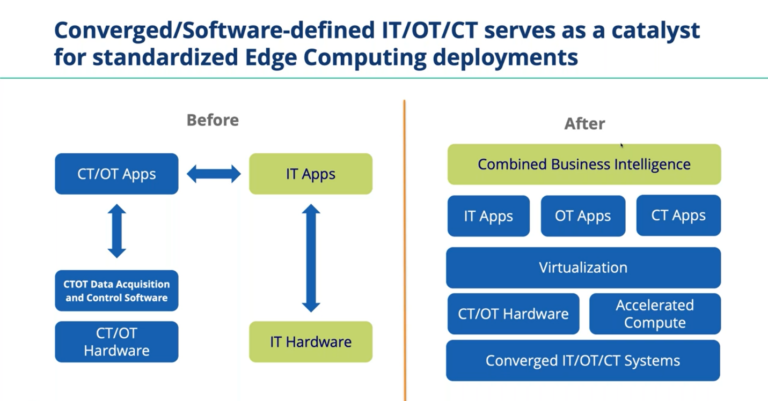Manufacturers are embracing the Internet of Things (IoT) and the importance of collecting and analyzing data to power digital transformation (DX) and improve business results. But embarking on the journey of digital transformation means understanding how edge computing fits into the organization, having the right infrastructure, and implementing IT/OT/CT convergence. Read on to learn the importance of digital transformation and best practices to get you started.
What Advances Can you Find on your Digital Transformation Journey?
- Migrate and Modernized systems. Modernizing systems can help organizations be more responsible and scalable while remaining secure in the new digital world.
- Build and extend digital platforms. Companies need to create new digital platforms that allow them to collect, analyze and share an ever-expanding range of data sets.
- Monetize digital services. This refers to building and continually enhancing digital services which can be used to engage with customers and automate business services.
The Importance of Edge Computing
Edge computing has a solid role to play within the Industrial Automation (IA) field. Its power can be found through the use of smart logistics, machine learning, and factory asset management. Each of which requires intelligence and the ability to analyze and utilize data captured by factories. In an increasingly connected world, edge computing is being looked at in a centralized fashion – gaining data intensity, connectivity and security and more.
Choosing the Right Infrastructure
Depending on the organizational viewpoint, edge infrastructure can be complementary to or inclusive of level 1 or 2 control and information layers of a production process. Organizational agreement on location, capabilities, and desired outcomes is critical before conducting any pilot or scalable implementations.
Edge computing within line applications requires limited bandwidth, large volumes of data, and device security. Plant applications, however, require a response time in seconds, multiple large volumes of data, and a modern network of infrastructure. It’s key to own a device with server virtualization, high availability, and operational simplicity, and lifespan.
Why Converged IT/OT/CT is Excellent for Edge Computing Deployments
The combined business intelligence of IT/OT/CT applications running on one virtualized system seamlessly carries out operational and data analytics functions. All without requiring separate infrastructures. Converging these areas is not only cost effective but also improves performance, productivity and agility.

Best Practices when Simplifying Computing at the Edge
- Get connected: What is your current connection environment when talking about analytics? Do you require various wireless technologies, ethernet routes, etc.?
- Rethink your infrastructure: What applications do you need to run and where do you need to run them? Are they latency sensitive, real-time oriented?
- Develop an architectural strategy: Prior use cases, reaching out the trusted partners, and looking at what your organization needs both internally and externally will help drive your architectural strategy.
Although the Industrial Internet of Things (IIoT) and smart manufacturing drove the first wave of industrial innovation, digital transformation is the next imperative.
For an in-depth conversation on which solutions can help simplify the digital transformation journey with edge computing, listen to our latest webinar. Senior Director Industry Solutions, John Fryer, and Group Vice President, Ashish Nadkarni, expand on these topics and outline the benefits of establishing an “Intelligent Edge.”
[sc name=”Edge_Computing_CTA_2″]